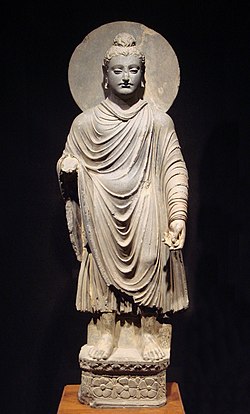| Sign of perfection | Causal Relation [19] |
|---|
| Flat soles | The Bodhisattva-mahasattva is immovable in his upholding of the precepts, in his mind of giving, and is like Mount Sumeru in abiding in the true word. |
| Thousand spokes | The Bodhisattva-mahasattva fittingly offers things to his parents, the honoured ones, elders, and animals. |
| Long fingers Long heels A square and upright body | The Bodhisattva-mahasattva takes joy in non-harming and non-stealing and is pleased regarding his parents, honoured ones and teachers. |
| Toe-membrane (like that of a great royal swan) | The Bodhisattva-mahasattva practices the four ways of guiding in [i.e. to guide beings in by: 1) giving, 2) friendliness, 3) good actions, 4) transforming himself and co-existing with them as the beings themselves], and takes in beings. |
| Soft hands and feet | The Bodhisattva-mahasattva, when his parents, teachers and elders are ill, himself washes and wipes, holds and rubs their limbs. |
| Joints and ankles fully fleshed Skin flows in one direction | The Bodhisattva-mahasattva upholds the precepts, listens to the sermons, and knows no end of giving. |
| Ankles of a deer-king | The Bodhisattva-mahasattva single-mindedly gives ear to Dharma and expounds the right teaching. |
| Body rounded and perfect (is like the nyagrodha tree) Fingers reaching the knee (when hand is stretched down) Usnisa (Buddhic protuberance on the crown of the head) | The Bodhisattva-mahasattva acquires no harming mind, is satisfied with his food and drink, and with giving, and attends to illness, and dispenses medicine. |
| Genital organ lies hidden | The Bodhisattva-mahasattva, when he sees a person in fear, extends help [to that person], and when he sees a person without any footgear, gives him clothing. |
| Delicately soft skin Bodily hair turns to the right-hand side | The Bodhisattva-mahasattva readily befriends wise men, segregating himself from the ignorant; he takes pleasure in exchanging views and sweeps the path along which he walks. |
| Body shines brightly in a golden colour and light | The Bodhisattva-mahasattva always gives men clothing, food and drink, medicine, incense and flowers, and lights. |
| Full and right-set (firm) in the seven places of the body | The Bodhisattva-mahasattva gives, does not grudge at [hang on to] whatever is rare, and easily parts with such; he makes no distinction whatever between a field of weal or a nonfield-of-weal [i.e. the recipient of dana - charity - is likened to a field, by cultivating which one's blessings and virtues increase]. |
| Boneless parts of the body are full (upper part is like that of a lion) Elbows well-balanced and delicate | The Bodhisattva-mahasattva seeks wealth lawfully and gives this away [to others]. |
| 40 teeth are white and pure, well-balanced and delicate | The Bodhisattva-mahasattva segregates himself from double-tongue [two-facedness], from ill-speaking and an angry mind. |
| Two-fanged face | The Bodhisattva-mahasattva practises Great Loving-Kindness towards beings. |
| Lion's cheeks | The Bodhisattva-mahasattva takes this vow: "Any may come and ask, and I shall give as they desire to have." |
| Taste that is the mid-upper | The Bodhisattva-mahasattva gives whatever kind of food beings desire to have. |
| Large and long tongue (i.e. a symbolic expression referring to his great prowess in oratory) | The Bodhisattva-mahasattva exerts himself in the 10 good deeds and thereby teaches others. |
| Buddha-Voice | The Bodhisattva-mahasattva does not speak ill of the shortcomings of others and does not slander Wonderful Dharma. |
| Blue tone of the eyes | The Bodhisattva-mahasattva sees all enmities and gains a pleasant [i.e. happy] mind. |
| White (tuft of) hair on the brow | The Bodhisattva-mahasattva does not conceal the virtues of others, but praises the good which they have. |









